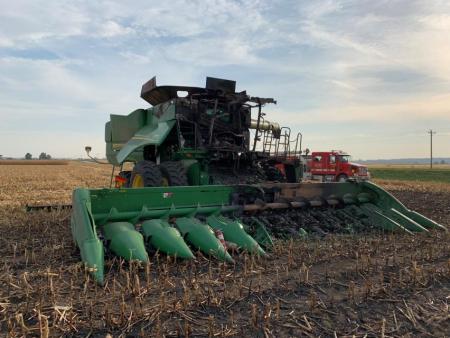October 4, 2021

Much of Iowa is currently abnormally dry or in some state of drought according to the latest U.S. Drought Monitor. If dry field conditions persist, the potential for combine and field fires this fall could continue to be a problem. Low relative humidity levels and high winds further amplify the risk of fires. All it takes is a single high-temperature source in the engine area or an overheated bearing to ignite dry plant material.
During harvest periods with increased fire potential, fires cause millions of dollars in property damage in Iowa, including loss of machinery, crops, and time. Injuries to farm workers and firefighters are also an unfortuate outcome in some instances.
Modern, high-productivity combines are powerful machines, which means they can produce excessive amounts of heat. Fire cannot start without heat and fuel. While you cannot remove the heat from the engine, hydraulics, and other hard-working systems, you can remove the fuel source by keeping your combine clean.

Prevention tips:
Keep the machine clean, particularly around the engine and engine compartment. Use a high pressure washer or compressed air to remove caked-on oil, grease, and crop residue.
Check coolant and oil levels daily.
Check the pressurized oil supply line to the turbocharger for wear areas that rub and may start an oil leak.
Frequently blow leaves, chaff and plant material from the engine area with compressed air or a portable leaf blower. Doing this one last time at night is better than in the morning when dew may make it harder to blow residue off.
Remove plant materials wrapped on or near bearings, belts, or other moving parts.
Examine exhaust or hot bearing surfaces. Repair leaking fuel or oil hoses, fittings or metal lines immediately.
Inspect and clean ledges or recessed areas near fuel tanks and lines.
Prior to fueling, turn the combine off and wait 15 minutes to reduce the risk of a spill volatilizing and igniting.
Research from South Dakota State University suggests that if we have dry conditions and start experiencing wind speeds close to 30 mph and above, it is likely fires will be inevitable, and producers should consider delaying harvest until evening hours when winds decrease or wait for precipitation.
Management tips:
In case of fire, call 911 first, and then attack with fire extinguishers if it is safe to do so. Try to fight from the “black," the area already burned. Attacking a fire from areas with combustibles (e.g. dry corn stalks) is much riskier.
A fire can double in size in less than a minute. Burning embers blown downwind can spread a fire well beyond the control of your fire extinguishers in just seconds.
Carrying two ABC-type fire extinguishers are recommended: a smaller 10-pound unit in the cab and a larger 20-pound extinguisher at ground level on the combine.
Invert and shake the extinguishers once or twice a season to ensure machine vibrations don’t compact the powder inside.
Keeping a shovel on the combine to throw dirt can also help.
Create lists of the 911 addresses for each of your field locations prior to harvest and have them easily accessible to family and farm employees. Many fire departments have GPS equipment onboard their apparatus to assist directing them to incidents. When an incident is called in with a 911 address, dispatch can more readily identify the incident location and relay this information to apparatus drivers. Precious time can be saved when apparatus are able to dispatch immediately with GPS guidance rather than having to doublecheck maps and directions.
Create an emergency plan:
Fires may start from plant materials that have smoldered unnoticed for 30 minutes or more. The ignition source for field fires may have been the earlier passing of a truck, tractor or combine. Flames aren’t apparent until additional oxygen is supplied, perhaps by a gust of wind. Harvest crews and neighbors may want to discuss a plan for emergency tillage of a firebreak should that option become advisable. As this ICM article from the spring of 2021 suggests, the goal of creating a firebreak with a tillage pass, is to stop an out of control fire from spreading.
Keep in mind that personal safety is more important than property loss. With current prospects for a dry harvest, fire prevention measures will be more important than usual.
Source: Iowa State University which is solely responsible for the information provided and is wholly owned by the source. Informa Business Media and all its subsidiaries are not responsible for any of the content contained in this information asset.
You May Also Like




